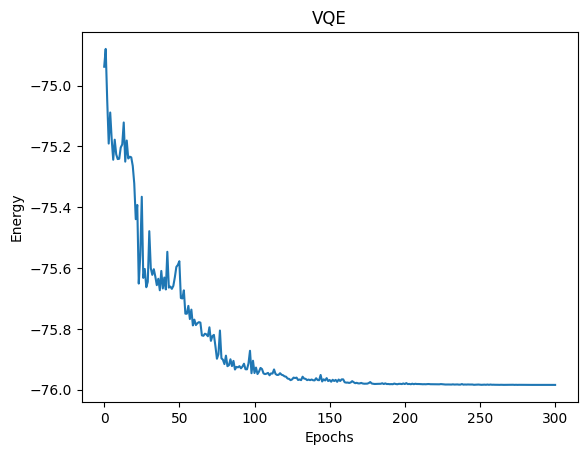import openfermion
import openfermionpyscf
from openfermion.transforms import jordan_wigner, get_fermion_operator
import timeit
import cudaq
import matplotlib.pyplot as plt
from scipy.optimize import minimize
import numpy as np
# GPU
cudaq.set_target("nvidia-fp64")
# CPU
#cudaq.set_target("qpp-cpu")
# 1- Classical pre-processing:
geometry = [('O', (0.1173,0.0,0.0)), ('H', (-0.4691,0.7570,0.0)), ('H', (-0.4691,-0.7570,0.0))]
basis = '631g'
multiplicity = 1
charge = 0
ncore = 3
norb_cas, nele_cas = (4,4)
molecule = openfermionpyscf.run_pyscf(openfermion.MolecularData(geometry, basis, multiplicity,charge))
molecular_hamiltonian = molecule.get_molecular_hamiltonian(
occupied_indices=range(ncore), active_indices=range(ncore, ncore + norb_cas))
fermion_hamiltonian = get_fermion_operator(molecular_hamiltonian)
qubit_hamiltonian = jordan_wigner(fermion_hamiltonian)
spin_ham = cudaq.SpinOperator(qubit_hamiltonian)
# 2- Quantum computing using UCCSD ansatz
electron_count = nele_cas
qubit_count = 2*norb_cas
@cudaq.kernel
def kernel(qubit_num:int, electron_num:int, thetas: list[float]):
qubits = cudaq.qvector(qubit_num)
for i in range(electron_num):
x(qubits[i])
cudaq.kernels.uccsd(qubits, thetas, electron_num, qubit_num)
parameter_count = cudaq.kernels.uccsd_num_parameters(electron_count,qubit_count)
# Define a function to minimize
def cost(theta):
exp_val = cudaq.observe(kernel, spin_ham, qubit_count, electron_count, theta).expectation()
return exp_val
exp_vals = []
def callback(xk):
exp_vals.append(cost(xk))
# Initial variational parameters.
np.random.seed(42)
x0 = np.random.normal(0, 1, parameter_count)
# Use the scipy optimizer to minimize the function of interest
start_time = timeit.default_timer()
result = minimize(cost, x0, method='COBYLA', callback=callback, options={'maxiter': 300})
end_time = timeit.default_timer()
print('UCCSD-VQE energy = ', result.fun)
print('Pyscf-CCSD energy = ', mycc.e_tot)
print('Total number of qubits = ', qubit_count)
print('Total number of parameters = ', parameter_count)
print('Total number of terms in the spin hamiltonian = ',spin_ham.get_term_count())
print('Total elapsed time (s) = ', end_time-start_time)
plt.plot(exp_vals)
plt.xlabel('Epochs')
plt.ylabel('Energy')
plt.title('VQE')
plt.show()
